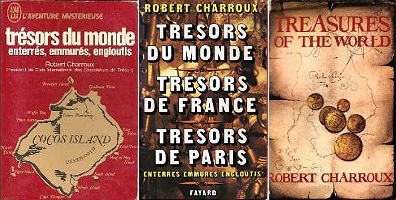La Dépêche du Midi
1 August 1962
WHAT HAPPENED WHEN THE CLUB DES CHERCHEURS DE TRÉSORS AND THE R.T.F. TOOK AN INTEREST IN RENNES-LE-CHATEAU
Of all the stories of buried treasure known to us, that of Rennes-le-Château is one of the most splendid. Actually, we don't really want to know whether the Cathar treasure is buried "somewhere" under the ancient Visigothic capital. When all's said and done, what does it matter – the legend is much more charming than the dry facts could ever be.
RENNES-LE-CHATEAU, FAVOURITE CHILD OF THE R.T.F.
Rennes-le-Château has already received several visits from the RTF. Who could ever forget the sight of Monsieur Noël Corbu in a cassock playing the part of the Abbé Saunière, the man who actually “found” the treasure. Last Monday afternoon yet another programme was recorded: once again the Abbé's archives have been raided, and Monsieur Corbu was required to answer a whole flurry of questions, and did so with very good grace. The R.T.F. certainly seems to be in love with Rennes-le-Château.
A CLUB “UNLIKE ANY OTHER”
This programme was not however quite like all the others. It was hosted by one Robert Charroux, president of the Club des Chercheurs de Trésors, who is himself the author of a wonderful book published by Fayard entitled “Trésors du monde”. The Club has 29 members. To join it you really do have to have discovered hidden treasure. A glance at the membership-list reveals some prestigious names, including Henry de Monfred, Captain Tony Mangel (“the last of the pirates”) and Florent Ramaugé, who, aboard Dod Osborne's famous boat the “Girl-Pat”, has spent six years searching for treasure in the Bay of Vigo. The club holds its meetings in an old counterfeiters' cave, and each member wears as an insignia a 3-espagnole piece recovered from a galleon. No one could create the right sort of atmosphere for the viewers of the programme better than Robert Charroux.
THE TREASURE-HUNT
Of course we're here to join in a treasure-hunt, which is why Robert Charroux is unveiling his “treasure-detector”. Imagine a Geiger-counter connected by a wire to a wooden wheel. A faint whistling noise is audible through the headphones. As soon as the wheel approaches a metallic object the whistling noise gets louder. And this isn't a pendulum or a dowsing-rod – this is science come to the aid of treasure-hunters.
A strange procession passes through the church and cemetery. The wheel of the treasure-detector has been trailed about just about everywhere. The devil in the stoup sets hearts pounding when the whistling-noise gets louder, but it turns out that this is just because of the iron plinth on which the squinting and decidedly battered but nonetheless sniggering Satan stands. Inside the church itself nothing “significant” is detected, apart from some items of scrap metal. In the cemetery it looks as if it's going to be the same story until, at the foot of the belfry, near the grave of Barthélemy Rivière, who died on 22 April in the year of grace 1896, the treasure-detector goes berserk and the ammeter needle goes off the scale. Robert Charroux turns and turns again, guiding the wheel backwards and forwards over the critical spot. Everyone holds their breath to await the verdict. Finally we have it: “Over a length of about one and a half metres there are three metallic spots, located at least one metre down.” That's all.
Since however the detector is only effective up to a metre in depth we can still keep our hopes high. Charroux promises to return with a better detector that's effective up to a depth of four metres.
AN APPEAL TO PARISIAN LISTENERS
Hopes of finding something at Rennes-le-Château have been raised even further by an appeal over the airwaves for two triangular stones bearing various key inscriptions. These two stones are believed to be somewhere in Paris. One is inscribed, “P. reddis celis regis arcis praecum” and the other, “Sae sis in medio linea ubi M. cecat linea parva P. S. Praecum.”
IF IT'S TRUE
And so the audience of channel “France I” is going to be regaled with the story of the treasure of Rennes-le-Château. A story well worth following perhaps, for if it's true then barrels full of gold really were discovered one day long ago.
|

